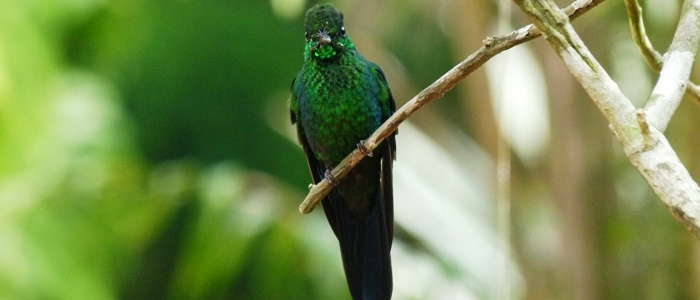Costa Rica offers nowadays a wide array of tourism options for its visitors, like Vacations on the Beach, Adventure Vacations, Vacations near Volcanoes, Multiday Wildlife Observation Excursions, Multiday Fishing Tours, etc. But there is one type of tourism that is gaining strength over the past 2 decades: Birdwatching in Costa Rica.
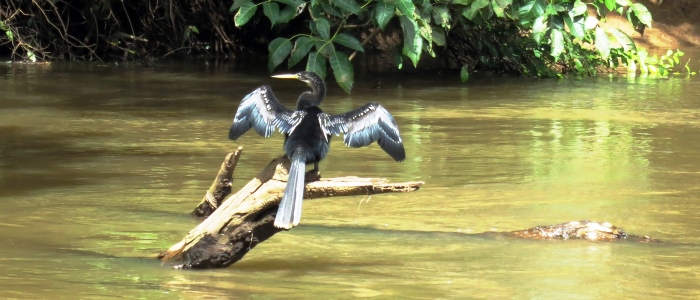
The country has several advantages that make it appropriate for this activity, like having a tremendous amount of bird species (over 800), divided in very different and varied life habitats and landscapes. Also, the birdwatchers could travel in this small Central American county a relatively short distance, where they would be able to enjoy of a large variety of birds without traveling a whole lot. The bird watchers can also learn about the vast variety of flora, and other wildlife that the country has to offer; among many other reasons like having comfortable accommodations or food options anywhere in the birdwatching spots of the country.
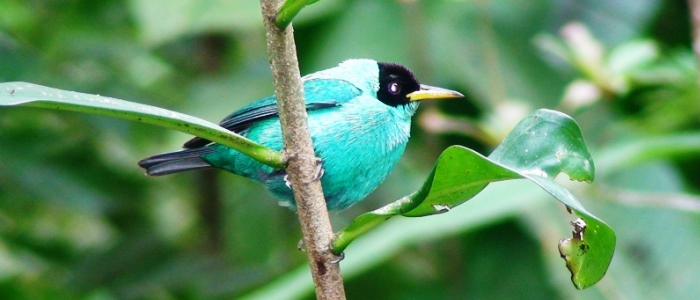
Near the town of Santa Elena for example, part of the Province of Puntarenas, there is a place called Monteverde Cloud Forest, located about 3 hours from San Jose. This place sits at about 1,800 meters above sea level (5000 feet), and is known for its large diversity of birds and other animal species as well. Once you make your 4 hour drive through the somewhat rough unpaved road, along the way you will be surrounded by beautiful scenery of the ex-goldmining towns, and howler monkeys will be there guiding you every turn. Once in the Monteverde Cloud Forest Reserve area, many hikes and hiking trails are there for the visitors to take along, some of them with Suspension Bridges, like the famous Selvatura Hanging Bridges Park or The Sky Adventures Hanging Bridges Park; but one thing that you will definitely notice is the chorus of birds echoing through the forest, and if you have a built-in eagle eye, you will be able to catch some birds in the surrounding tree branches and on the tree canopy, or maybe you will experience what I did the first time that I went, you will hear exotic bird calls but can’t see a thing. Some of the birds that are common to be observed in this area, is the amazing intense green and red colored Resplendent Quetzal, this is usually a very quiet bird, so you would need to have your 20/20 vision on point at all times, since they usually rest on the tree branches, but the tricky part of this is that since it’s a green bird, it’s very easy to blend in with its surroundings; but once you lay your eyes on it, its presence is just impressive and makes you want to never lay your eyes off of it. On the flip side, there is a super loud noise that echoes through the forest… literally, the locally famous Three-waddled Bell Bird, which some call it “the bilingual bird”. This is a bird that is very popular for its bell like call, but the reason why they call it the bilingual bird is because it has 3 very soft and peaceful calls, and then it lets out a massive loud yet amazing bell like sound. This is actually one of my favorite birds due to the sound that they make and the 3 waddles that it has on its beak, which looks like the bird is simulating the catch of three worms.
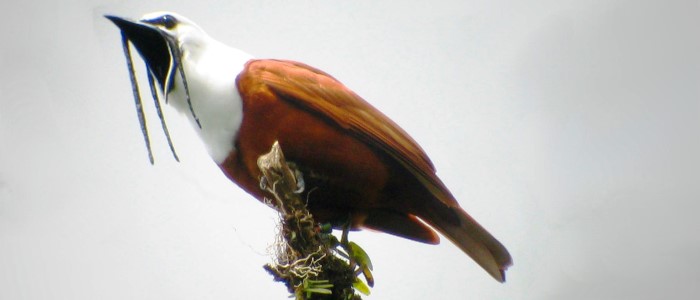
There is one unfortunate thing about this whole bird thing, the reasons are unknown so far, but there is one very exotic, very rare yet beautiful bird that is in extinction and this was the king of the Monteverde Cloud Forest: the bare-necked umbrella-bird. This beautiful dense black and red bird will be sure to take you breath away and you will agree with me that it is by far the most beautiful thing that I have seen, now as mentioned before, this is a very rare bird that can be found in the Monteverde Cloud Forest. Other birds that can be seen in this area are many Guans, Herons, Barn Owls, Ruby-throated Hummingbirds, trogons, motmots, laughing falcon and thanks to global warming, now seeing toucans is a common thing, but not that great for this fragile eco-system, since the toucan is a predator of other bird species and the ones in Monteverde, and other Cloud Forest areas don’t know how to deal with it, since they are not used to handle them… In a nutshell this is one of the best places to visit if you are a photographer or in general a bird kind of person looking to do some Birdwatching in Costa Rica.
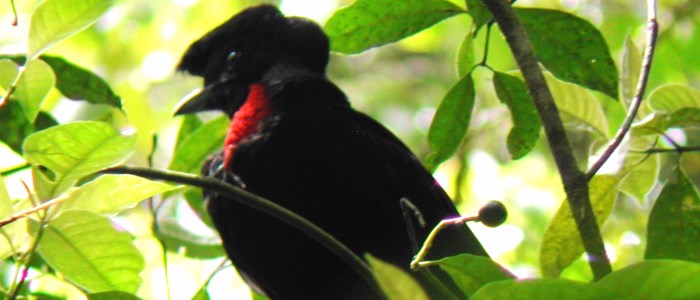
Going back to the subject of traveling short distances, you could drive just one hour from Monteverde and be in another super rich habitat for Birdwatching in Costa Rica: our Tropical Rainforests. Now onto the Rainforest, the most common and ideal rainforest for birdwatching is located in the Tirimbina Biological Reserve in the area of Sarapiqui. Sarapiqui is also located about 3 hours from San Jose and it stands at only 200 meters (500 feet) above sea level. This area is known for its large varieties of wildlife such as jungle cats, tapirs, monkeys, sloths, bullet ants, poison dart frogs and of course lots of birds, making this also a very ideal place for birdwatching. Let’s go ahead and talk about the kind of birds that can be seen here. One real friendly bird that is very accessible to the eye, is the Chestnut-Mandibled toucan, this beautiful colored, long beaked bird is known for hanging around tree tops, which feeds of insects, fruits, lizards and other things. Now a fun fact, just like the Scarlett Macaws, these birds fly usually in pairs or even in flocks, meaning that if you at some point spot a Toucan, another one should be around as well.

Some other birds that you might hear more than you see, it’s the large varities of parakeets, ranging from all different colors in spectrum. Also the beautiful small purple-colored honeycreeper; or the rufous motmot, this tall bird is by far one of the most beautiful in the area, this green and orange long tailed bird has a very quiet humming sound, so in order to hear it you would need to be very still and quiet. This is one of my favorite birds to see in this area, so be on the lookout and have you cameras ready. Other popular birds in the Sarapiqui area are the Chesnutt Mandible Toucans, the Passerini Tanagers, Clay-Color Robbins (Costa Rica’s National Bird), White Collared Manakins, Collared Aracaris and others, that many times can be easily spotted at the gardens of the hotels and houses of this whole area!
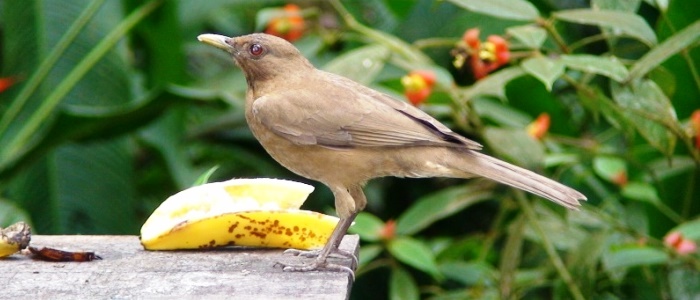
Bird watching in Costa Rica can also be done in difference habitats outside of the Rainforest and Cloud Forest, like our Dry Tropical Forest. While you make your way to Manuel Antonio National Park for example, you will pass through the town of Tarcoles and Jaco Beach; and as you drive along those Dry Forest areas, you could spot flocks of Scarlett Macaws eating almonds in the surrounding trees. These beautiful birds cannot be missed, because they are very loud and pretty big in size. In this specific area, you could also spot some Caracaras as well, but those are a bit hard to catch. Speaking of hard to see, the Harpy Eagle is also on this list, but there have been some sights of this huge Bird of Prey in the South Pacific Regions of Costa Rica.
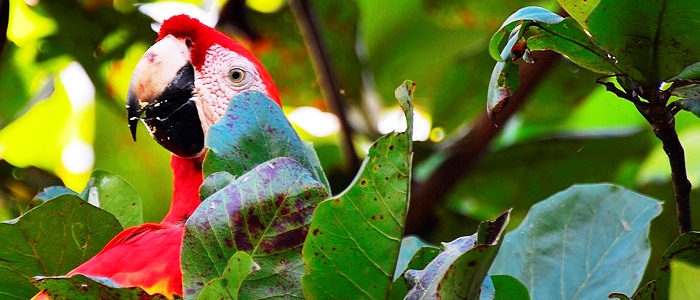
This is just a little idea of the kind of birds that Costa Rica has to offer and some that you might come across while traveling to our country.
